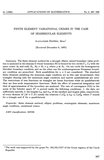Article
Full entry |
 PDF
(3.8 MB)
Feedback
PDF
(3.8 MB)
Feedback
 PDF
(3.8 MB)
Feedback
PDF
(3.8 MB)
Feedback
Keywords:
finite element method; elliptic problems; semiregular elements; maximum angle condition; variational crimes
finite element method; elliptic problems; semiregular elements; maximum angle condition; variational crimes
Summary:
The finite element method for a strongly elliptic mixed boundary value problem is analyzed in the domain $\Omega $ whose boundary $\partial \Omega $ is formed by two circles $\Gamma _1$, $\Gamma _2$ with the same center $S_0$ and radii $R_1$, $R_2=R_1+\varrho $, where $\varrho \ll R_1$. On one circle the homogeneous Dirichlet boundary condition and on the other one the nonhomogeneous Neumann boundary condition are prescribed. Both possibilities for $u=0$ are considered. The standard finite elements satisfying the minimum angle condition are in this case inconvenient; thus triangles obeying only the maximum angle condition and narrow quadrilaterals are used. The restrictions of test functions on triangles are linear functions while on quadrilaterals they are four-node isoparametric functions. Both the effect of numerical integration and that of approximation of the boundary are analyzed. The rate of convergence $O(h)$ in the norm of the Sobolev space $H^1$ is proved under the following conditions: 1. the
References:
[1] I. Babuška, and A.K. Aziz: On the angle condition in the finite element method. SIAM J. Numer. Anal. 13 (1976), 214–226. DOI 10.1137/0713021 | MR 0455462
[2] M. Feistauer, and A. Ženíšek: Finite element solution of nonlinear elliptic problems. Numer. Math. 50 (1987), 451–475. DOI 10.1007/BF01396664 | MR 0875168
[3] P. Jamet: Estimations d’erreur pour des éléments finis presque dégénérés. RAIRO Anal. Numér. 10 (1976), 43–61. MR 0455282
[4] M. Křížek: On semiregular families of triangulations and linear interpolation. Appl. Math. 36 (1991), 223–232. MR 1109126
[5] J. Nečas: Les Méthodes Directes en Théorie des Equations Elliptiques. Academia-Masson, Prague-Paris, 1967. MR 0227584
[6] L.A. Oganesian, and L.A. Rukhovec: Variational-Difference Methods for the Solution of Elliptic Problems. Izd. Akad. Nauk ArSSR, Jerevan, 1979. (Russian)
[7] A. Ženíšek: Nonlinear Elliptic and Evolution Problems and Their Finite Element Approximations. Academic Press, London, 1990. MR 1086876
[8] A. Ženíšek, and M. Vanmaele: The interpolation theorem for narrow quadrilateral isoparametric finite elements. Numer. Math. 72 (1995), 123–141. DOI 10.1007/s002110050163 | MR 1359711

